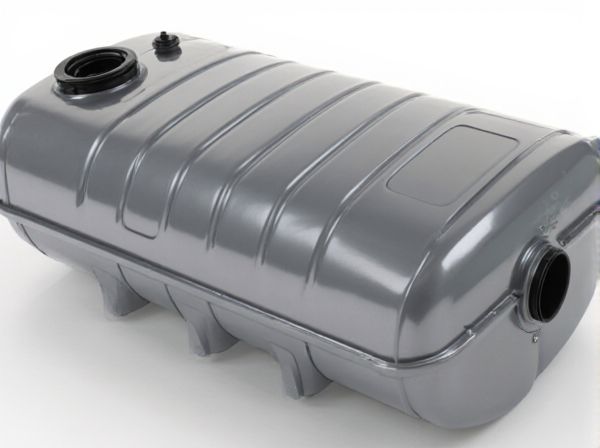
Photo illustration: Saddle Tank vs Single Tank
Choosing between a saddle tank and a single tank depends on your vehicle's design and fuel capacity requirements. Saddle tanks are mounted on either side of the vehicle's frame, providing balanced weight distribution and easier access for maintenance, while single tanks are typically large, centrally located units that maximize fuel volume in a compact space. Your decision should consider factors like available installation space, desired fuel range, and vehicle stability.
Table of Comparison
| Feature | Saddle Tank | Single Tank |
|---|---|---|
| Design | Two tanks mounted on both sides of the vehicle chassis | One single tank mounted centrally |
| Fuel Capacity | Higher total capacity due to dual tanks | Limited to size of one tank |
| Weight Distribution | Even weight distribution across both sides | Weight concentrated in one area |
| Space Utilization | Uses side space efficiently, may increase vehicle width | Compact, requires less width, uses undercarriage space |
| Installation Complexity | More complex, requires dual fillers and fuel lines | Simpler installation with one filler and line |
| Maintenance | Requires monitoring and maintenance of two tanks | Easier to maintain a single tank |
| Cost | Typically higher due to dual components | Lower upfront cost |
Introduction to Fuel Tank Configurations
Saddle tanks are fuel containers mounted on either side of a vehicle or vessel, optimizing space and balance by distributing weight evenly across the chassis. Single tanks, typically positioned centrally, offer simplicity and ease of maintenance but may limit fuel capacity and affect weight distribution. Choosing between saddle tanks and single tanks depends on design requirements, fuel capacity needs, and vehicle stability considerations.
What Is a Saddle Tank?
A saddle tank is a type of fuel or water tank that is mounted on the sides of a vehicle or locomotive, resembling a saddle draped over a horse. Unlike a single tank, which is usually positioned centrally or underneath, saddle tanks provide balanced weight distribution and increased capacity without compromising ground clearance. This design enhances vehicle stability and is commonly used in trucks, trains, and agricultural machinery.
What Is a Single Tank?
A single tank refers to a single, large fuel storage unit commonly mounted on motorcycles or trucks, designed to hold fuel efficiently in one centralized location. Unlike saddle tanks, which consist of two separate tanks on either side of the vehicle, a single tank consolidates fuel capacity into one container, simplifying the fuel system and maintenance. This design often results in a lower center of gravity and streamlined aesthetics, enhancing stability and overall vehicle performance.
Design Differences Between Saddle and Single Tanks
Saddle tanks are designed to straddle the frame of a motorcycle, providing a low center of gravity and better weight distribution compared to single tanks, which are mounted solely on top of the frame. Single tanks typically offer a more streamlined shape and simpler construction, making them lighter but less effective in balancing the bike's stability. The key design difference lies in how saddle tanks envelop the frame and often increase fuel capacity, while single tanks focus on minimalism and aerodynamic efficiency.
Advantages of Saddle Tanks
Saddle tanks provide improved weight distribution by mounting fuel tanks on either side of a vehicle's frame, enhancing stability and handling compared to a single tank. These tanks offer easier access for maintenance and inspection, reducing downtime during servicing. Their design allows for increased fuel capacity without compromising the central chassis space, beneficial for long-haul trucks and heavy-duty vehicles.
Advantages of Single Tanks
Single tanks offer increased fuel capacity within a compact design, maximizing storage space without requiring additional chassis modifications. Their centralized placement improves vehicle balance and stability, enhancing safety during operation. Maintenance and inspection processes are streamlined due to easier access, reducing downtime and operational costs.
Common Applications and Industries
Saddle tanks are commonly used in heavy-duty trucks, construction equipment, and agricultural machinery due to their lower center of gravity and improved stability, which enhances safety and handling. Single tanks are prevalent in smaller commercial vehicles, light-duty trucks, and passenger vans where space efficiency and simplicity are prioritized for fuel storage. Industries such as logistics, agriculture, and construction favor saddle tanks for durability and higher fuel capacity, while delivery and service sectors prefer single tanks for ease of maintenance and lighter weight.
Safety Considerations: Saddle vs Single Tanks
Saddle tanks, mounted on either side of a vehicle's frame, offer improved stability and lower center of gravity compared to single tanks, reducing the risk of rollovers in heavy trucks and buses. Single tanks, typically positioned under the chassis, may be more vulnerable to side impacts, increasing the likelihood of fuel leakage and fire hazards. Safety protocols recommend saddle tanks for applications requiring enhanced balance and impact resistance, while single tanks demand reinforced shielding to mitigate crash-related risks.
Fuel Efficiency and Capacity Comparisons
Saddle tanks offer increased fuel capacity by utilizing two side-mounted tanks, improving overall range and reducing refueling stops, which enhances fuel efficiency during long hauls. Single tanks typically have lower capacity but provide a centralized fuel source, potentially simplifying maintenance and reducing weight, leading to slightly better mileage in light-load conditions. Fuel efficiency in saddle tanks excels under heavy-duty usage due to balanced weight distribution and extended capacity, while single tanks benefit short trips with less complex fuel management.
Choosing the Right Tank Type for Your Vehicle
Choosing the right tank type for your vehicle depends on its size, weight distribution, and fuel capacity requirements. Saddle tanks offer better weight distribution on larger trucks and provide additional fuel capacity without increasing vehicle height, making them ideal for long-haul applications. Single tanks are simpler, lighter, and easier to service, best suited for smaller vehicles or those with limited space.
 caratoz.com
caratoz.com